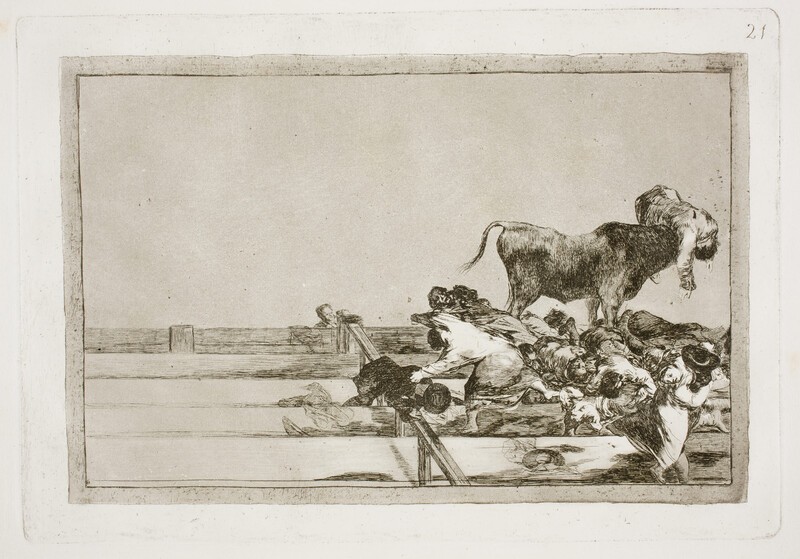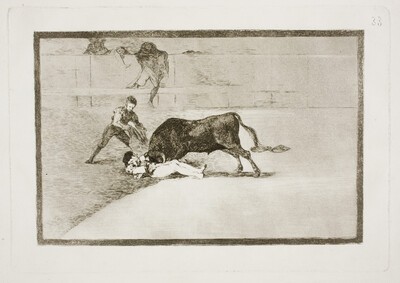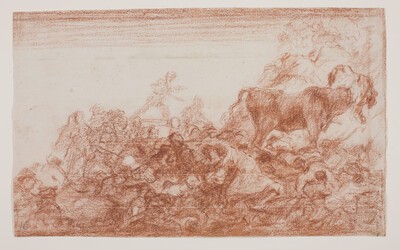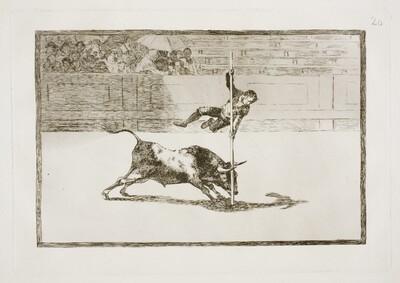- Cronología
- 1814 - 1816
- Dimensiones
- 247 x 353 mm
- Técnica y soporte
- Reconocimiento de la autoría de Goya
- Documented work
- Ficha: realización/revisión
- 02 Oct 2021 / 22 Jun 2023
- Inventario
- -
21 (print, upper right-hand corner)
See How the ancient Spaniards hunted bulls on horseback in the countryside
A state proof before aquaitint, wash and burnisher is preserved in the Provôt Collection in Paris.
The plate is kept at the National Chalcography (nº 354)
See How the ancient Spaniards hunted bulls on horseback in the countryside
Another of the most characteristic images of bullfighting. It narrates an event which, although its veracity is questioned by some authors, is usually identified with a real event that took place on June 1801 in the Madrid bullring, in which a bull leapt into the arena and carried off several people, killing two of them, one of them the mayor of the nearby town of Torrejón of Ardoz, who in the picture appears skewered, already dead, on the horns of the bull.
The most striking feature of the engraving is its unique point of view, its impossible and absurd perspective, which places the viewer at the same height as the audience. The composition is deliberately asymmetrical and unbalanced in the distribution of the masses, as Goya arranges the chaotic crowd grouped together in only a quarter of the available space, with sketchy, foreshortened figures, leaving the rest of the space almost empty, no doubt with the aim of increasing the sense of anxiety and unease that he intended to convey. Furthermore, the action takes place entirely in the stands of the bullring, without the arena playing a leading role, which breaks with the usual location of composition of bullfighting scenes.
Although it refers to a specific event, Goya omits any detail that would allow us to identify the figures. Among the people crowded together on the right of the scene, we see how some figures flee to the left, while others are almost paralysed with fear, as in the case of a woman in the foreground on the right, whose face is unhinged with fright and who is being held by a man in a hat. There are bodies on the ground, crushed or trampled by the bull. The bull is on the right of the composition, in profile, its head covered by the skewered body of the mayor of Torrejón, from which one of the animal's horns is sticking out.
Count la Viñaza has already drawn attention to an enigmatic figure with his head peeping out from the outside of the barrier, observing the scene with a calm look, who seems to have Goya's physiognomy and could therefore be a self-portrait. Perhaps Goya's intention in this print was to denounce the insecurity of bullrings.
Martínez-Novillo relates this engraving, because of its crude bullfighting drama, to that of the death of Pepe Hillo, entitled The Unfortunate Death of Pepe Illo in the Bullring in Madrid, although in that case he changes the scene of a spectator being caught for that of a bullfighter.
Bagüés and Lafuente Ferrari were the first to situate the action depicted on the 15th June 1801, when the fourth bull from a Palaciosrubios (Salamanca) bull-ranch jumped into the bullring in Madrid and fell in the passage of the marshals' exit gate. Mayer and Martínez-Novillo, for their part, also speak of the royal functions of 1789, with historical references to bulls that jumped the barrier.
This print, despite grouping the figures in a very small part of the composition like the one immediately before it, entitled Lightness and Daringness of Juanito Apiñani in the one in Madrid, contrasts sharply with it, as that one had a playful sense and this one has a dramatic one.
Goya made a preparatory drawing for the present engraving, although very different, also entitled Misfortune in the bullring in Madrid and death of the mayor of Torrejón
-
Grabados y dibujos de Goya en la Biblioteca NacionalBiblioteca NacionalMadrid1946catalogue Elena Páez Ríos
-
Goya en la Biblioteca Nacional. Exposición de grabados y dibujos en el sesquicentenario de su muerteBiblioteca NacionalMadrid1978May - June 1978
-
Grabados de Goya: colección propiedad de la Biblioteca Nacional, que se conserva en su Gabinete deCasa de la Amistad de MoscúMoscow1979exhibition displayed from January 18th to 31st 1979
-
Goya. Das Zeitalter der Revolucionen. Kunst um 1800 (1980 – 1981)Hamburger KunsthalleHamburg1980cat. 98
-
1984
-
Madrid1987
-
Madrid1990cat. 36
-
Goya grabadorMuseo del Grabado Español ContemporáneoMarbella1996from March 8th to May 5th 1996
-
Zaragoza1996
-
Ydioma universal: Goya en la Biblioteca NacionalBiblioteca NacionalMadrid1996from September 19th to December 15th 1996cat. 290
-
Schlaf der Vernunft. Original radierungen von Francisco de GoyaMunich2000
-
Madrid2002
-
Madrid2002
-
Goya en tiempos de guerraMuseo Nacional del PradoMadrid2008consultant editor Manuela B. Mena Marqués, from April 14th to July 13th 2008cat. 155
-
Bilbao2012
-
Goya luces y sombrasCaixaForumBarcelona2012consultant editors José Manuel Matilla and Manuela B. Marqués. From March 16th to June 24th 2012cat. 63
-
Goya et la modernitéPinacothèque de ParisParís2013from October 11st 2013 to March 16th 2014cat. 33
-
Goya: Order and disorderMuseum of Fine ArtsBoston2014cat. 222
-
Zaragoza2017
-
Agen2019cat. 66
-
Madrid2019cat. 136
-
Zaragoza2021
-
MadridTipografía M.G. Hernández1887p. 411
-
ZaragozaTip. del Hospicio1926p. 32
-
BarcelonaLabor1925p. 272
-
1946pp. 177-216, espec. p. 200
-
BarcelonaTartessos-F. Oliver Branchfelt1946 (reed. 1951)
-
1961pp. 120-127
-
OxfordBruno Cassirer1964vol. II, 1964, p. 336, cat. 224
-
Vie et ouvre de Francisco de GoyaParísOffice du livre1970p. 278, cat. 1192
-
Goya, Das Zeitalter de Revolutionen. 1789-1830HamburgPrestel-Verlag Münche und Hamburger Kunsthalle1980p. 145
-
MilwakeeMilwaukee Art Museum1986pp. 18, 19, 24 y 32
-
MadridCaser-Turner1992pp. 32-34 y 39
-
Catálogo de las estampas de Goya en la Biblioteca NacionalMadridMinisterio de Educación y Cultura, Biblioteca Nacional1996cat. 342
-
Ydioma universal: Goya en la Biblioteca NacionalMadridBiblioteca Nacional, Sociedad Estatal Goya 96 y Lunwerg1996p. 255
-
MadridMuseo Nacional del Prado2001pp. 76-78
-
MadridMuseo Nacional del Prado y Ediciones El Viso2008pp. 432-434, cat. 154-155
-
Goya en tiempos de guerraMadridMuseo Nacional del Prado2008p. 433
-
ParísPinacoteca de París2013p. 108
-
Goya: Order & DisorderBostonMuseum of Fine Arts Boston Publications2014p. 322
-
Goya. In the Norton Simon MuseumPasadenaNorton Simon Museum2016pp. 186-201
-
AgenSnoeck2019p.121
-
MadridMuseo Nacional del Prado2019p. 217, cat. 136
-
Goya. Traveler and artist of the Grand Tour (exp. cat.)ZaragozaGobierno de Aragón2021pp. 232-233



